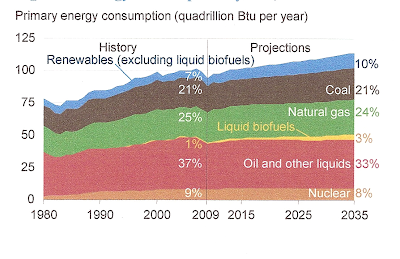By Bob van der Valk
Dateline: Terry, Montana, February 2, 2011
On January 25, 2011 President Obama proposed in his State of the Union speech to eliminate $4 billion a year in tax exemptions for oil and gas companies as well as another $200 million a year in exemptions for the coal industry. That money in turn could be used to subsidize clean energy projects.
In case you missed it, following is the excerpt from the speech specifically dealing with the energy industry:
The following EPA graph shows the estimated breakdown in primary energy consumption sources through the year 2035:
In a perfect world all energy should be recycled without having to explore for and produce additional reserves. But that is not the way we are currently heading with a variety of programs being supported by government subsidies or by threats of imposing huge fines. Those alone are keeping bio-fuels on the front burner as the panacea to be used as an alternative energy source. The graph shows that this would only increase the use of renewable fuels by 3% between 2009 and 2035.
Bob van der Valk is an Independent Consultant in the petroleum industry with over 50 years of experience in the gasoline and lubricants industry. He has been often quoted by news media and his opinion solicited by government entities, in addition to his ongoing daily business of managing large scale supply and marketing operations.
The views and opinions expressed herein are the author's own and do not necessarily reflect those of Economic Forecasts & Opinions (EconForecast).

Market News and Data brought to you by Benzinga APIsDateline: Terry, Montana, February 2, 2011
On January 25, 2011 President Obama proposed in his State of the Union speech to eliminate $4 billion a year in tax exemptions for oil and gas companies as well as another $200 million a year in exemptions for the coal industry. That money in turn could be used to subsidize clean energy projects.
In case you missed it, following is the excerpt from the speech specifically dealing with the energy industry:
“We've begun to reinvent our energy policy. We're not just handing out money. We're issuing a challenge. We're telling America's scientists and engineers that if they assemble teams of the best minds in their fields, and focus on the hardest problems in clean energy, we'll fund the Apollo projects of our time.Using food for bio-fuels--especially in Western countries--is counter productive to keeping the price for those staples affordable, but that is exactly what is being encouraged by the proposed federal subsidies. This is mainly driven by concerns about diminishing oil supply and global warming resulting from greenhouse gases produced from an increased worldwide use of fossil fuels.
At the California Institute of Technology, they're developing a way to turn sunlight and water into fuel for our cars. At Oak Ridge National Laboratory, they're using supercomputers to get a lot more power out of our nuclear facilities. With more research and incentives, we can break our dependence on oil with bio-fuels, and become the first country to have a million electric vehicles on the road by 2015.
We need to get behind this innovation. And to help pay for it, I'm asking Congress to eliminate the billions in taxpayer dollars we currently give to oil companies. I don't know if you've noticed, but they're doing just fine on their own. So instead of subsidizing yesterday's energy, let's invest in tomorrow's.
Now, clean energy breakthroughs will only translate into clean energy jobs if businesses know there will be a market for what they're selling. So tonight, I challenge you to join me in setting a new goal: By 2035, 80 percent of America's electricity will come from clean energy sources.
Some folks want wind and solar. Others want nuclear, clean coal and natural gas. To meet this goal, we will need them all -- and I urge Democrats and Republicans to work together to make it happen.”
The following EPA graph shows the estimated breakdown in primary energy consumption sources through the year 2035:
In a perfect world all energy should be recycled without having to explore for and produce additional reserves. But that is not the way we are currently heading with a variety of programs being supported by government subsidies or by threats of imposing huge fines. Those alone are keeping bio-fuels on the front burner as the panacea to be used as an alternative energy source. The graph shows that this would only increase the use of renewable fuels by 3% between 2009 and 2035.
- Certificates are bought and sold between energy producers in order to be able to continue to exceed allowable pollutant emitting standards set by the Clean Air Act.
- Federal incentives for using the highest blend possible for soybean and alcohol in fuels.
- A variety of economic initiatives depending upon the different types of feedstock used for bio-fuels production.
- Incentives for returning “waste-byproduct” in the form of algae farms as agricultural fertilizer.
- Federal support for research and development with volume mandates set for the use of alternative fuels mostly by the military.
Bob van der Valk is an Independent Consultant in the petroleum industry with over 50 years of experience in the gasoline and lubricants industry. He has been often quoted by news media and his opinion solicited by government entities, in addition to his ongoing daily business of managing large scale supply and marketing operations.
The views and opinions expressed herein are the author's own and do not necessarily reflect those of Economic Forecasts & Opinions (EconForecast).
© 2025 Benzinga.com. Benzinga does not provide investment advice. All rights reserved.
Benzinga simplifies the market for smarter investing
Trade confidently with insights and alerts from analyst ratings, free reports and breaking news that affects the stocks you care about.
Join Now: Free!
Already a member?Sign in
